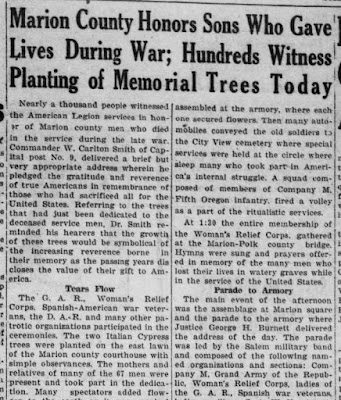 |
| Civil War Memorial in City View (November 2019): "Erected in memory of deceased brave defenders of our country in the civil war of 1861-1865"* |
 |
| Local ad grids, with "Gettysburg speech" Morning paper May 30th Afternoon paper, May 29th, both 1920 |
The afternoon paper's graphic is more interesting and layered, and uses "Memorial Day." As I read it, it shows pair of Civil War Veterans, one Union, the other Confederate, saluting each other, and preparing to salute the Doughboys marching up in formation between them.
 |
| Union and Confederate Veterans saluting, Doughboys marching |
 |
| May 31st, 1920 |
Not many are left in the fast-thinning ranks of those who fought in the Civil War and each year fewer and fewer of the gray-haired veterans follow the flag they love so well to scatter flowers in loving memory of departed comrades. The veterans of the Spanish-American war are still in the prime of life, while most of the thousands who gave their life for democracy abroad still rest in foreign graves.There's a lot there to consider, especially the disillusioned mood of futility. It's clear, though, the way it transitions attention from one war to a more recent one.
Of the three wars, the last was the greatest and inspired by the loftiest ideals. The Civil War was fought to preserve the Union, the Spanish-American to defend the national honor, but America entered the world war not only to preserve the Union, defend the national honor, but to preserve freedom for humanity, liberate oppressed peoples and prevent future wars.
However, this Memorial Day, we must mourn the fallen ideals as well as fallen soldiers. Our citizens, soldiers and sailors performed miracles of valor to extend the Declaration of Independence to the world, but our politicians refuse to complete the program. Congress has repudiated any responsibility in the preservation of liberty abroad or the prevention of future wars. Instead of a memorial to peace we are erecting a monument to golden greed.
One striking element is the way that "liberate oppressed peoples" is not applied to the Civil War, but only to World War I. There's nothing about slavery here.
Compare this to the editorial from 1918. Even as it discusses transition and talks about "a new Memorial Day," it specifically calls out "the great war which gave the black man his freedom...after a bitter struggle and a fratricidal one."
 |
| May 30th, 1918 |
By 1920 slavery was erased. The variation over just two years might be an artifact of changing ownership or other vagaries, but I read it as telling and symptomatic of a more general shift in popular attitudes. Understandings for both Memorial Day and the Civil War were reimagined and renewed, and one telling of the Civil War, more about Union than slavery, crowded out the other.
Administratively, the State Librarian, Cornelia Marvin, had been in charge of compiling names of those who died during World War I. ODVA, founded in 1945, didn't exist yet.
 |
| May 29th, 1920 |
 |
| May 31st, 1920 |
* It has seemed that the statue might date to 1933, but there are reasons to think it dates instead to 1905. (See this post from last Fall for more detail.)
 |
| A plaque below the statue for something dedicated in 1933 but it may commemorate a very different event |
 |
| March 10th, 1905 |


No comments:
Post a Comment